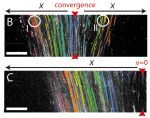EPJ E Highlight - Self-forming biological scaffolding
- Details
- Published on 21 October 2012

A model system that can interpret the role of cross-linking proteins.
A new model system of the cellular skeletons of living cells is akin to a mini-laboratory designed to explore how the cells’ functional structures assemble. A paper just published in EPJ E by physicist Volker Schaller and his colleagues from the Technical University Munich, Germany, presents one hypothesis concerning self-organisation. It hinges on the findings that a homogeneous protein network, once subjected to stresses generated by molecular motors, compacts into highly condensed fibres.
The contractile machinery inside cells is arguably the most prominent example of cells’ ability to self-organise cellular proteins into highly ordered functional structures involved in cell division or cell migration, for example.
The authors attempt to elucidate how such highly self-organised structures emerge from a less ordered and homogeneous collection of constituent proteins. Namely, such proteins are actin filaments—one of the main scaffold proteins in cells made of biopolymers—and associated molecular motors. The latter exerts forces by pressing along the filament, an energy consuming process.
Schaller and colleagues reconstituted a minimal model system of the cellular skeleton consisting of actin filaments held together by cross-linking proteins and molecular motors. They found that this minimal system is sufficient to reproduce similar self-organisation processes observed in nature.
In particular, they showed that a homogeneous network of actin filaments held together by the cross-linking protein α-actinin can rapidly be reorganised by molecular motor proteins. It contracts to form a highly heterogeneous set of compact fibres consisting of millions of individual filaments, resembling scaffold structures inside the cellular skeleton.
The authors also realised that the efficiency of this reorganisation process, and therefore the length scale of the fibres created, directly depend on motor activity. Thus, the fibres can range between 5μm and up to 100μm in length for low and high motor activity, respectively.
Active compaction of crosslinked driven filament networks. V. Schaller, B. Hammerich und A. R. Bausch, Eur. Phys. J. E (2012) 35: 81, DOI 10.1140/epje/i2012-12081-2




